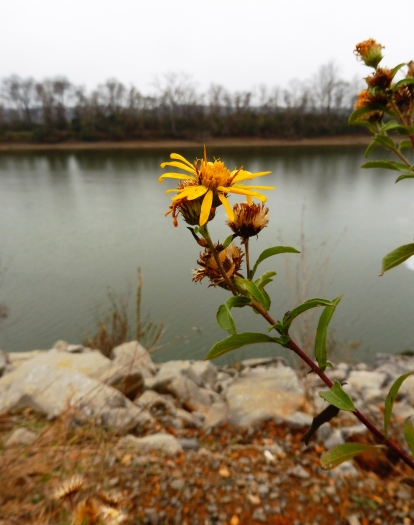Lemonyellow False Goldenaster
(Heterotheca camporum)
Lemonyellow False Goldenaster (Heterotheca camporum)
/
/

Mason Brock (Masebrock)
Public domain
Image By:
Mason Brock (Masebrock)
Recorded By:
Copyright:
Public domain
Copyright Notice:
Photo by: Mason Brock (Masebrock) | License Type: Public domain | License URL: https://creativecommons.org/public-domain/ | Uploader: Masebrock | Publisher: Wikimedia Commons | Title: Heterotheca_camporum.jpg | Notes: |




























Estimated Native Range
Summary
Heterotheca camporum, commonly known as Lemonyellow False Goldenaster, is a deciduous perennial herb native to a variety of habitats including prairies, open woodlands, and roadsides throughout the Central United States. It typically grows up to 150 centimeters (5 feet) in height and can spread through its underground rhizomes, forming dense clumps. The plant features narrow, lance-shaped leaves and bears bright yellow, daisy-like flowers from late summer to fall, which are highly attractive to pollinators such as bees and butterflies.
Lemonyellow False Goldenaster is valued for its vibrant yellow blooms that add color to the garden late in the season when many other plants have finished flowering. It is often used in wildflower gardens, naturalized areas, and as a border plant. This species is drought-tolerant once established, making it suitable for xeriscaping and gardens with poor, dry soils. It requires minimal maintenance, though deadheading can encourage additional blooming. While generally pest-free, it can occasionally suffer from mildew in humid conditions.CC BY-SA 4.0
Lemonyellow False Goldenaster is valued for its vibrant yellow blooms that add color to the garden late in the season when many other plants have finished flowering. It is often used in wildflower gardens, naturalized areas, and as a border plant. This species is drought-tolerant once established, making it suitable for xeriscaping and gardens with poor, dry soils. It requires minimal maintenance, though deadheading can encourage additional blooming. While generally pest-free, it can occasionally suffer from mildew in humid conditions.CC BY-SA 4.0
Plant Description
- Plant Type: Herb
- Height: 1-3 feet
- Width: 1-2 feet
- Growth Rate: Moderate
- Flower Color: Yellow
- Flowering Season: Summer, Fall
- Leaf Retention: Deciduous
Growth Requirements
- Sun: Full Sun
- Water: Low, Medium
- Drainage: Fast
Common Uses
Bee Garden, Bird Garden, Butterfly Garden, Drought Tolerant, Low Maintenance, Showy Flowers
Natural Habitat
Native to prairies, open woodlands, and roadsides in the Central United States
Other Names
Common Names: Prairie Golden-Aster, Golden Aster
Scientific Names: , Heterotheca camporum, Chrysopsis camporum, Heterotheca villosa var. camporum, Chrysopsis villosa var. camporum, Heterotheca camphorum,
GBIF Accepted Name: Heterotheca camporum (Greene) Shinners